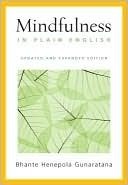More on this book
Community
Kindle Notes & Highlights
Meditation deals with levels of consciousness that lie deeper than conceptual thought. Therefore, some of the experiences of meditation just won’t fit into words.
Learning to look at each second as if it were the first and only second in the universe is essential in vipassana meditation.
There are three integral factors in Buddhist meditation — morality, concentration, and wisdom. These three factors grow together as your practice deepens. Each one influences the other, so you cultivate the three of them at once, not separately.
Within the Judeo-Christian tradition we find two overlapping practices called prayer and contemplation. Prayer is a direct address to a spiritual entity. Contemplation is a prolonged period of conscious thought about a specific topic, usually a religious ideal or scriptural passage. From the standpoint of mental cultivation, both of these activities are exercises in concentration. The normal deluge of conscious thought is restricted, and the mind is brought to one conscious area of operation. The results are those you find in any concentrative practice: deep calm, a physiological slowing of
...more
Out of the Hindu tradition comes yogic meditation, which is also purely concentrative. The traditional basic exercises consist of focusing the mind on a single object — a stone, a candle flame, a syllable, or whatever — and not allowing it to wander. Having acquired the basic skill, the yogi proceeds to expand his practice by taking on more complex objects of meditation — chants, colorful religious images, energy channels in the body, and so forth. Still, no matter how complex the object of meditation, the meditation itself remains purely an exercise in concentration.
Within the Buddhist tradition, concentration is also highly valued. But a new element is added and more highly stressed: the element of awareness. All Buddhist meditation aims at the development of awareness, using concentration as a tool toward that end. The Buddhist tradition is very wide, however, and there are several diverse routes to this goal. Zen meditation uses two separate tacks. The first is the direct plunge into awareness by sheer force of will. You sit down and you just sit, meaning that you toss out of your mind everything except pure awareness of sitting. This sounds very
...more
This highlight has been truncated due to consecutive passage length restrictions.
Another stratagem, tantric Buddhism, is nearly the reverse. Conscious thought, at least the way we usually do it, is the manifestation of ego, the “you” that you usually think that you are. Conscious thought is tightly connected with self-concept. The self-concept or ego is nothing more than a set of reactions and mental images that are artificially pasted to the flowing process of pure awareness. Tantra seeks to obtain pure awareness by destroying this ego image. This is accomplished by a process of visualization. The student is given a particular religious image to meditate upon, for
...more
This highlight has been truncated due to consecutive passage length restrictions.
Vipassana is the oldest of Buddhist meditation practices. The method comes directly from the Satipatthana Sutta, a discourse attributed to the Buddha himself. Vipassana is a direct and gradual cultivation of mindfulness or awareness. It proceeds piece by piece over a period of years. One’s attention is carefully directed to an intense examination of certain aspects of one’s own existence. The meditator is trained to notice more and more of the flow of life experience. Vipassana is a gentle technique, but it also is very, very thorough. It is an ancient and codified system of training your
...more
This highlight has been truncated due to consecutive passage length restrictions.
The object of vipassana practice is to learn to see the truths of impermanence, unsatisfactoriness, a...
This highlight has been truncated due to consecutive passage length restrictions.
This brings up a new, major rule for your meditation: When any mental state arises strongly enough to distract you from the object of meditation, switch your attention to the distraction briefly. Make the distraction a temporary object of meditation.
We want you to move away from thinking, back to a direct, wordless, and nonconceptual experience of the breath.
Here is the problem: When a distraction, or any mental state, arises in the mind, it blossoms forth first in the unconscious. Only a moment later does it rise to the conscious mind. That split-second difference is quite important, because it is time enough for grasping to occur. Grasping occurs almost instantaneously, and it takes place first in the unconscious. Thus, by the time the grasping rises to the level of conscious recognition, we have already begun to lock on to it. It is quite natural for us to simply continue that process, getting more and more tightly stuck in the distraction as
...more
Our three questions, “What is it? How strong is it? And, how long does it last?” are a clever remedy for this particular malady.


